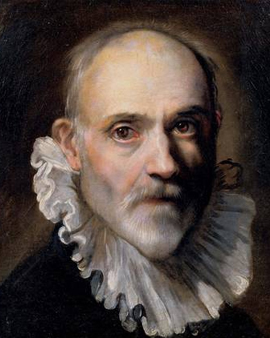Federico Barocci, also known as Fiori da Urbino, was a great Italian painter, draughtsman and graphic artist. His year of birth is not exactly known and is between 1526 and 1535. The father Ambrogio di Federico Barocci was a sculptor in Urbino and grandson of the important sculptor Ambrogio da Milano. The young Barocci was apprenticed to the painter Battista Franco called Semolei and later worked for some time with his maternal uncle Bartolomeo Genga, an architect, where he learned the basics of geometry and perspective.
In 1548 Federico Barocci went to Rome to study the works of Raphael and Correggio, among others. After a few years, the artist returned to Urbino and carried out numerous commissions, such as the paintings "Saint Cecilia" and "Martyrdom of Saint Sebastian" for the Urbino Cathedral. In 1560, back in Rome, Barocci collaborated in the workshop of the brothers Taddeo and Federico Zuccari, and together with Federico Zuccari he painted frescoes in rooms of the Vatican commissioned by Pope Pius IV. His painting "Four Virtues" became very famous.
In the course of the work in Rome, Federico Barocci fell very ill. He may have been poisoned by a fellow painter who envied his fame. He survived, but was very weakened for a long time and also frail as a result. About 1563, therefore, the artist returned to Urbino, and remained in his native country for the rest of his life. The Duke Francesco Maria II. della Rovere of Urbino protected him and provided him with further commissions. All attempts by foreign ecclesiastical and secular dignitaries, even by kings and emperors, to lure him to their courts, he refused due to ill health. Instead, in his home studio in Urbino, he created his most famous paintings, such as "Deposition from the Cross" "Rest on the Flight", "Nativity of Christ", "Madonna del Popolo", "Annunciation" and two depictions of the "Last Supper", in a style that was entirely his own and unmistakable.
Federico Barocci was a painter who worked very methodically, making countless sketches before his actual paintings. He made compositional and, figurative studies with models experimented with lighting, perspective, colors. His estate includes over 2,000 drawings by him. In 1612 the artist died in his hometown.
×





.jpg)
.jpg)
.jpg)
.jpg)
.jpg)
.jpg)
.jpg)
.jpg)
 - (MeisterDrucke-176664).jpg)
 - (MeisterDrucke-176664).jpg)
 - (MeisterDrucke-57171).jpg)
 - (MeisterDrucke-57171).jpg)
.jpg)
.jpg)
.jpg)
.jpg)
.jpg)
.jpg)
.jpg)
.jpg)
 - (MeisterDrucke-42593).jpg)
 - (MeisterDrucke-42593).jpg)
.jpg)
.jpg)
.jpg)
.jpg)
 - (MeisterDrucke-267698).jpg)
 - (MeisterDrucke-267698).jpg)
.jpg)
.jpg)
 c 1600-1610 - (MeisterDrucke-8528).jpg)
 c 1600-1610 - (MeisterDrucke-8528).jpg)
.jpg)
.jpg)
.jpg)
.jpg)
 - (MeisterDrucke-242775).jpg)
 - (MeisterDrucke-242775).jpg)
.jpg)
.jpg)
.jpg)
.jpg)
_-_De_heilige_Franciscus_knielend_voor_crucifix_-_(MeisterDrucke-1356484).jpg)
_-_De_heilige_Franciscus_knielend_voor_crucifix_-_(MeisterDrucke-1356484).jpg)
.jpg)
.jpg)
.jpg)
.jpg)
.jpg)
.jpg)
_-_(MeisterDrucke-322985).jpg)
_-_(MeisterDrucke-322985).jpg)
 - (MeisterDrucke-182595).jpg)
 - (MeisterDrucke-182595).jpg)
.jpg)
.jpg)
.jpg)
.jpg)
.jpg)
.jpg)
.jpg)
.jpg)
.jpg)
.jpg)
_-_(MeisterDrucke-1339085).jpg)
_-_(MeisterDrucke-1339085).jpg)
 - (MeisterDrucke-185561).jpg)
 - (MeisterDrucke-185561).jpg)
.jpg)
.jpg)
.jpg)
.jpg)
.jpg)
.jpg)
.jpg)
.jpg)
.jpg)
.jpg)
.jpg)
.jpg)
.jpg)
.jpg)
.jpg)
.jpg)
.jpg)
.jpg)
.jpg)
.jpg)
.jpg)
.jpg)
.jpg)
.jpg)
.jpg)
.jpg)
.jpg)
.jpg)
.jpg)
.jpg)
.jpg)
.jpg)
.jpg)
.jpg)
.jpg)
.jpg)
.jpg)
.jpg)
.jpg)
.jpg)
.jpg)
.jpg)
.jpg)
.jpg)
.jpg)
.jpg)
.jpg)
.jpg)
.jpg)
.jpg)
.jpg)
.jpg)
.jpg)
.jpg)
.jpg)
.jpg)
.jpg)
.jpg)
.jpg)
.jpg)
_Study_of_a_Landsca_-_(MeisterDrucke-1614302).jpg)
_Study_of_a_Landsca_-_(MeisterDrucke-1614302).jpg)
_-_(MeisterDrucke-1362601).jpg)
_-_(MeisterDrucke-1362601).jpg)
.jpg)
.jpg)
.jpg)
.jpg)
.jpg)
.jpg)
.jpg)
.jpg)
.jpg)
.jpg)
.jpg)
.jpg)
.jpg)
.jpg)
.jpg)
.jpg)
.jpg)
.jpg)
.jpg)
.jpg)
.jpg)
.jpg)
_-_(MeisterDrucke-310400).jpg)
_-_(MeisterDrucke-310400).jpg)
.jpg)
.jpg)
.jpg)
.jpg)
.jpg)
.jpg)
.jpg)
.jpg)
.jpg)
.jpg)
.jpg)
.jpg)
.jpg)
.jpg)
_c_1600-1610_-_(MeisterDrucke-1570001).jpg)
_c_1600-1610_-_(MeisterDrucke-1570001).jpg)
.jpg)
.jpg)
 - (MeisterDrucke-200549).jpg)
 - (MeisterDrucke-200549).jpg)
.jpg)
.jpg)
.jpg)
.jpg)
.jpg)
.jpg)
.jpg)
.jpg)
.jpg)
.jpg)
_-_(MeisterDrucke-194219).jpg)
_-_(MeisterDrucke-194219).jpg)
.jpg)
.jpg)
.jpg)
.jpg)
.jpg)
.jpg)
.jpg)
.jpg)
.jpg)
.jpg)
.jpg)
.jpg)






